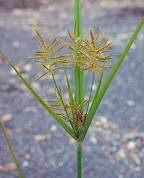Nutsedge
Scientific name:
Cyperus spp.
Synonym: Flatsedge
 Yellow nutsedge
Yellow nutsedge
Photo courtesy of Dan Tenaglia
Missouriplants.com
Habitat
Cultivated crops and of gardens
Affected crops
Most agricultural crops
Distribution
Worldwide
Description
Important nutsedge species
Purple nutsedge, Nutgrass (C. rotundus)
The stem is erect, smooth, sharply triangular, slender, and thickened at the base. The leaves are linear but shorter than the flowering stem. There are 3 rows
of leaves near the plant base. The leaf-like bracts under the flower clusters are shorter than the flowers. The flower is simple and occasionally produces seeds. The seed head is red or purplish-brown. The plant is propagated by tubers which are ovate, black, and have a bitter taste. The rhizome (root-like and horizontal-growing stem growing just below the surface of the soil) is wiry and bears connected tubers.
Rice flatsedge (C. iria)
The stem is sharply angled, hairy, smooth, and occurrs in bunches. The leaves are three-ranked, dark-green, shiny, linear and taper abruptly to a point, and have rough margins toward the leaf tips. The leaf-like bracts under the flower cluster are longer than the flowers. The flowers are yellowish. The roots are fibrous and yellowish-red. The plant is propagated by seeds. Each plant can produce up to 5,000 seeds.
Smallflower umbrella sedge, Rice sedge (C. difformis)
The
stem is green, solitary, erect, and triangular. It has 3-4 basal leaves. The leaves are short and thin. The flowers are yellowish, very numerous, and crowded ovoid masses. The plant is propagated by seeds. Each plant can produce up to 50,000 seeds.
Yellow nutsedge, Yellow nutgrass (C. esculentus)
The stem is usually solitary and produces terminal spikelets. The leaves are erect, yellow to green and shiny with distinct ridges, arrowing gradually to a sharp point. The seed head is yellow. The plant is propagated by tubers which are round, white, and sweet in taste. The rhizome bears only one tuber.
Effects and impacts
Nutsedge is one of the world's worst weeds. It can reduce rice yields by 50%. It serves as an alternate host for blast, bacterial leaf blight, armyworm, crickets, nematodes, paddy bug, plant hoppers, thrips, rice caseworm, and rice stemborer (Rice IPM, 2001).
Studies show that Smallflower
umbrella sedge is found to be resistant to Azimsulfuron, Bensulfuron-methyl, Cinosulfuron, Cyclosulfamuron, Ethoxysulfuron, Halosulfuron-methyl, Imazosulfuron, and Pyrazosulfuron-ethyl on rice fields in South Korea (Weed Science, 2005).
Methods of control
- Deep plowing and proper field level
- For seed bearing species, cut the weeds before they flower
- Repeated tillage or soil disturbance
- Flooding
- Proper seed selection
- Mulching
- Crop rotation with pigeon pea. Pigeon pea has the ability to control the emergence and growth of nutsedge (Kebede, 2004, p.4).

